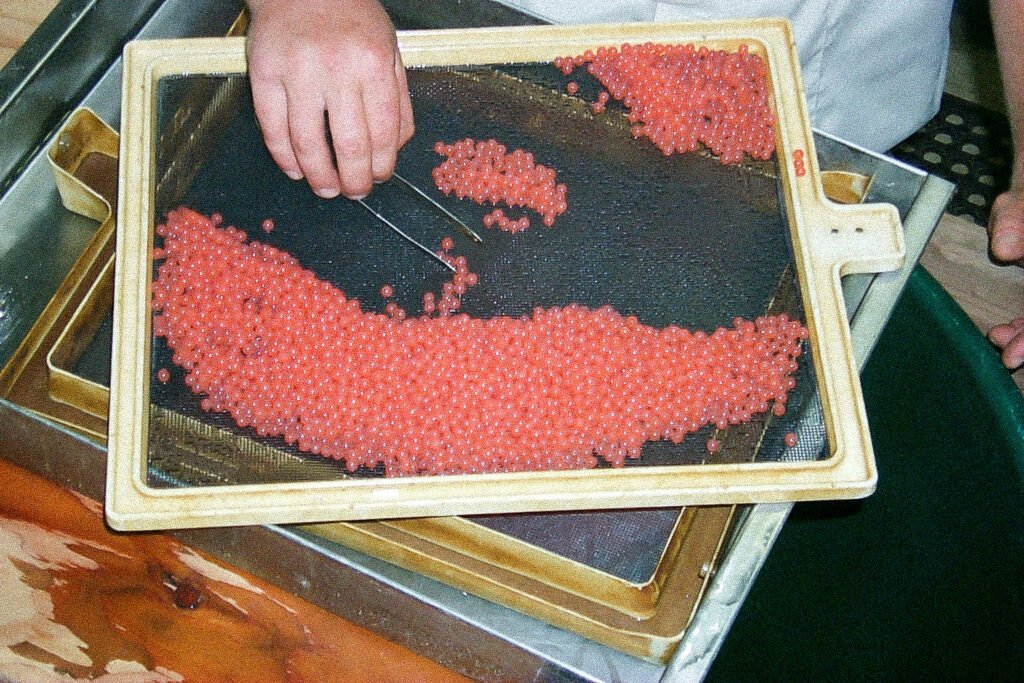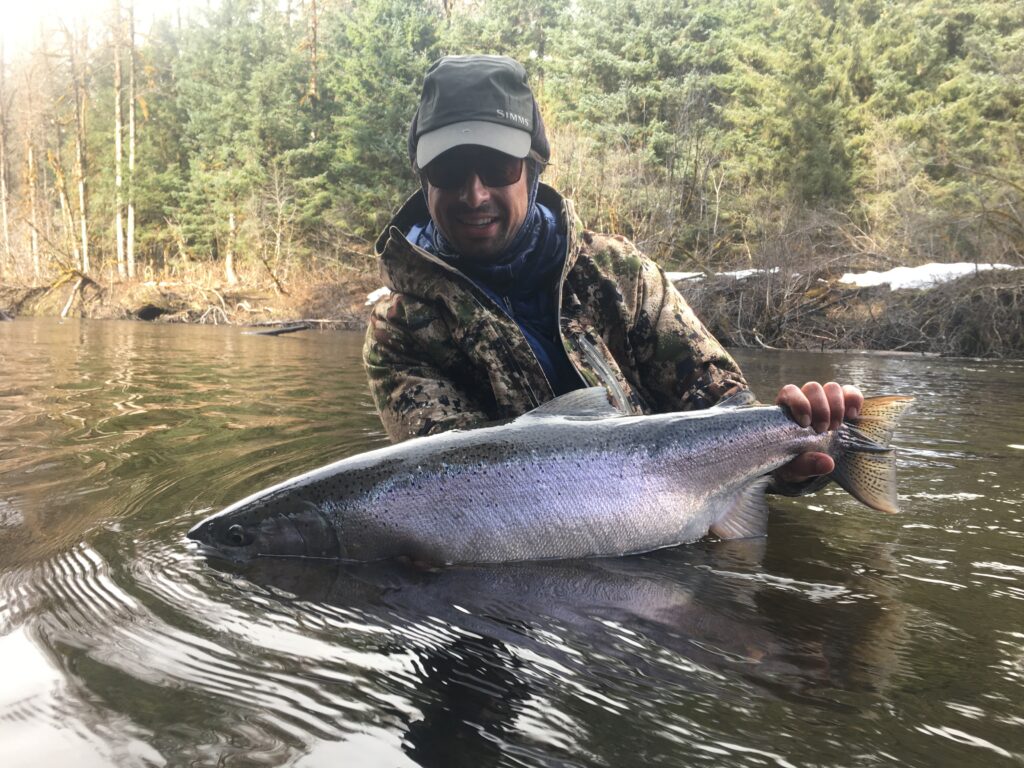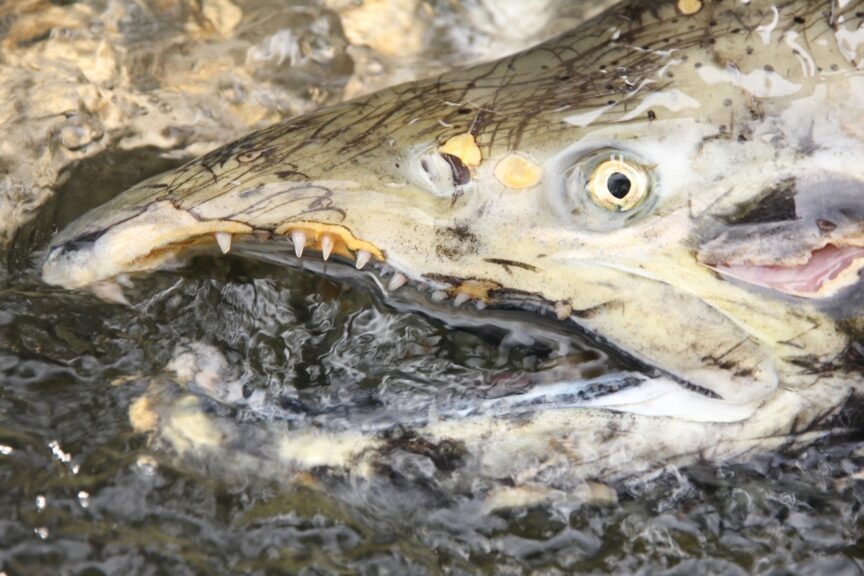
Our Science Advisor, Gary Marston, collaborated with NOAA, WDFW, and USFWS researchers to study the loss of fecundity in Washington Chinook populations
When evaluating the health of salmon and steelhead populations, there are a number of factors beyond abundance that biologists and managers need to consider, including productivity, diversity, and the spatial distribution of adult and juvenile fish throughout available habitat.
While all these factors are important, productivity is particularly important because it relates to how many offspring we might expect from each successfully spawning adult salmon or steelhead. It is also a key metric in developing escapement goals and managing fisheries.
Despite its importance for future fish populations, fisheries management has primarily focused on abundance and much less work has focused on productivity and the factors that influence it. One key piece of information that deserves more attention are trends associated with fecundity (i.e. how many eggs each female salmon or steelhead produces when they spawn.)
A recent study published in 2023 looked at this metric for Chinook Salmon in Washington and the results were eye opening.
This research was led by Michael Malick from NOAA Fisheries, with co-authors from the Washington Department of Fish and Wildlife (WDFW), NOAA Fisheries and the US Fish and Wildlife Service (USFWS). While working for WDFW, I contributed to the study as a coauthor by analyzing how changes in Chinook body size impacts fecundity.
Fecundity trends of Chinook salmon in the Pacific Northwest
Our study focused on assessing the fecundity trends of Chinook Salmon populations across Washington State to determine how they had changed over time and what factors are influencing that change. Fecundity is particularly challenging to assess in wild populations as it requires counting how many eggs each female salmon lays, so we instead focused on hatchery stocks and assessed 25 years of data collected across 43 hatchery stocks, which included both integrated (hatchery and wild) and segregated (hatchery only) broodstocks.
We found that over the years we evaluated, there was a marked decline in the fecundity of Chinook Salmon with the most significant decline occurring after 2013, when El Nino returned and kicked off a period of marine heat waves in the North Pacific.
In fact, between 2009 and 2017, on average, there was a 19% decline across all stocks. The declines were most pronounced in Fall Chinook populations originating from the Puget Sound, Washington Coast, and Lower Columbia River, with some populations experiencing up to a 35% reduction in fecundity. This means a female Chinook Salmon that historically produced approximately 4,000 eggs now only produces 2,600.

Above: Chinook salmon eggs. Image: John Rueth/USFWS
For the vast majority of stocks that we reviewed, fecundity had declined. Interestingly, Spring Chinook populations in two regions showed a different pattern. Fecundity data was stable for Upper Columbia Spring Chinook stocks, while Puget Sound Spring Chinook showed a slight increase in fecundity over the time series. It is unclear why these two groups fared better than the majority of Chinook populations studied, but a variety of factors, such as their run timing, physiology, fisheries pressure, oceanic distribution, and environmental factors, could be at play. Or it could simply be an artifact of the limited data for Spring Chinook populations compared to Fall Chinook, which account for the majority of populations in the study.
What was driving these changes to Chinook productivity?
A number of previous studies have indicated that there is a relationship between body size and fecundity in salmon. (For example, see Healey and Heard 1984 and Beacham and Murray 1993). So, that was the first place we looked.
Sure enough, in the populations we studied, we found that there were significant reductions in body size across all age classes of female Chinook between 2009 and 2017, with the oldest fish showing the sharpest declines. The reduced fecundity we saw was highly correlated with these reductions in body size. In fact, changes in body size accounted for over 60% of the annual variation in fecundity. Based on our results, we estimated that a just a single millimeter reduction in body length results in 7.8 fewer eggs produced by a female Chinook.
These results also raise additional questions. First and foremost, is whether this decline is reversible. The answer to this question may be complicated, as it appears that the reduction in fecundity coincided with a recent series of marine heatwaves, so perhaps when ocean conditions improve so will fecundity.

Image: USFWS, Pacific Region
However, the fact that the loss of fecundity is strongly correlated with reductions in body size may suggest otherwise. While our study covered 25-years of available fecundity data, looking at longer-term Chinook return data based on coded-wire tag recoveries going back to the 1970’s, many stocks also show a steep reduction in body size prior to our study period.
A second question raised by the study is what other factors are influencing this loss of fecundity. While body size explained over 60% of the trend, the remaining 40% is yet to be determined and will be a subject of future research.
The final major question raised by the study are whether similar losses of fecundity are occurring in other anadromous species such as Coho Salmon or steelhead.
Steelhead Data From the Situk River
This brings us to steelhead, where fecundity trends remain unstudied. As covered in our recent blog post on El Nino, several studies have indicated that during warm El Nino years steelhead often return at smaller body sizes when compared those returning during cold years due to shifts to less energy-rich prey during warm years. For example, this trend has been observed in data from Alaska’s Situk River, which shows that between 2002 and 2012 the average length of female steelhead was 773 mm but declined to 739 mm between 2013 and 2022. Thats a loss of 34 mm, approximately (1.3) inches in average length of fish (ADFG data 2023).

Image: Alaska Department of Fish and Game
While that might not seem like a lot, if we remember back to Chinook, it could mean a significant loss of fecundity. It is certainly worth further investigation, especially as this reduction in body size has coincided with record low returns to the Situk River and rivers across the Pacific Northwest.
Far-reaching implications for management and conservation
For fisheries managers, the documented decline in fecundity and associated loss of productivity should be wake up call, as well as a recognition of the need to regularly review and update fisheries regimes with the latest science and prioritize studies to fill knowledge gaps.
Current fisheries regimes in the Pacific Northwest typically either target specific exploitation rate objectives (i.e. what percent of the population can be harvested by the fishery) or are focused on escapement objectives at a maximum sustained yield (i.e. the maximum number of fish that can be harvested while still fully seeding the watershed).
Traditionally, changes in fecundity are not accounted for in stock assessment activities used to set these fisheries regimes and as such managers run the risk of overestimating future population sizes and what sustainable harvest rates should look like. In short, with Chinook returning at smaller sizes, and therefore producing fewer eggs and offspring, traditional fishery regimes could easily lead to overexploiting the populations.

Image: Luke Kelly
For example, the fisheries objectives for steelhead on the Washington coast are based on maximum sustained yield escapement goals that have remained unchanged for nearly 40 years. A key assumption with these harvest regimes is that the fecundity of these populations is stable or the same as it was historically. If that isn’t true, then current escapement goals won’t be able to produce stable populations going forward, especially when considering the well-documented loss of diversity on the coast.
In the face of climate change and its impacts on marine food webs and freshwater productivity, on top of a legacy of habitat loss and historic overharvest, many wild populations of salmon and steelhead are already nearing a tipping point. As such, these findings add to the need for fisheries managers to be cautious, especially during years of low marine productivity, to ensure enough fish successfully spawn. It drives home the need to reevaluate and update fisheries and escapement objectives on a regular basis.
This study on Chinook Salmon shows a disturbing connection between declining body size and fecundity and perfectly illustrates the need for similar studies on steelhead populations.
Most importantly, it is essential that managers recognize that fecundity changes over time. These shifts, especially when it has declined, must be accounted for better in fisheries management, to ensure that we are not overexploiting salmon and steelhead populations or preventing their recovery.


